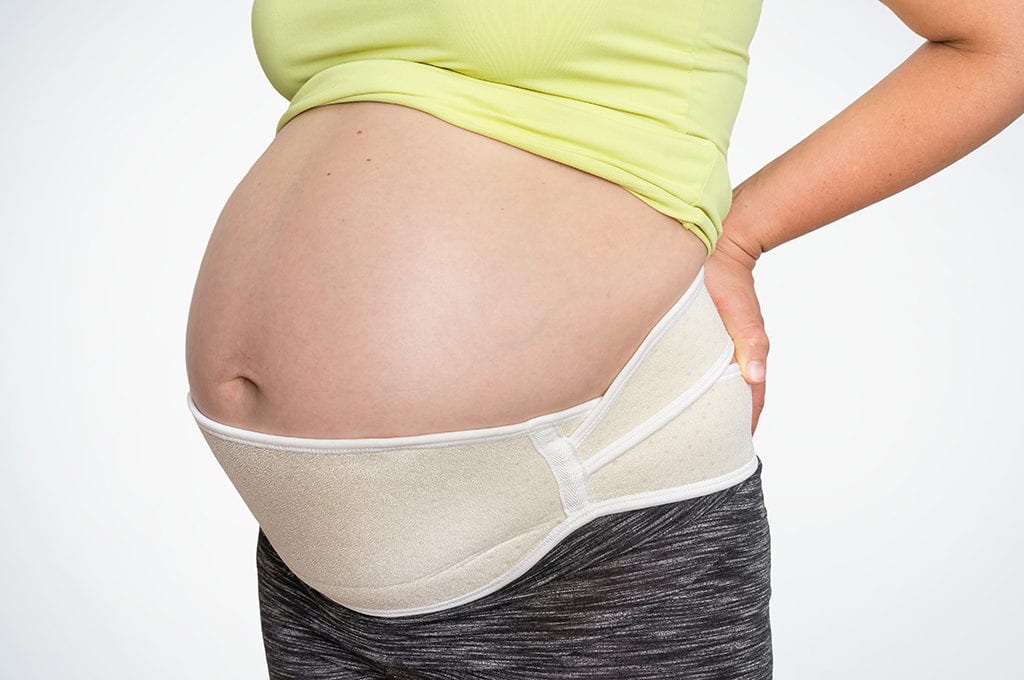Pregnancy belts can help to improve pelvic stability
By Isa Herrera, MSPT, CSCS, founder of www.PelvicPainRelief.com
Wearing a supportive belt during pregnancy can make a positive difference for women suffering from low back pain, pelvic pressure, diastasis recti separation, sacroiliac joint pain, Symphysis Pubic Dysfunction, pelvic instability, and incontinence. Women who use belts can sometimes have immediate pain relief; experience better day-to-day functioning and can carry out their days with less pain and discomfort. When I was pregnant with my child, I was the poster child for belts. I used many different types including the sacroiliac joint belt and the prenatal support belt. I am convinced that I was able to continue working and to stay active during pregnancy because these belts helped me to have a more stable pelvis and gave me tremendous pain relief.
I frequently hear: “I used a belt and it didn’t help me.” But I find that the women who are not getting positive results with a belt are either not using the correct type of belt or are wearing the belt incorrectly. In this blog, I will review several different types of belts and how they can benefit you. The importance of exploring belts in general and working with the ones that give you the most pain relief, support and stability cannot be overstressed. I’ve seen over and over again that women are much better able to deal with the demands of pregnancy and postpartum recovery when they add a belt to the healing toolbox. Belts are used until the muscles get strong and the pelvis is stable again. The best combination for pregnant women is a sensible workout or yoga program along with belting. Once the muscles get stronger, and the body is more stable pregnant women can wean themselves off the belt.
Three types of pregnancy belts
1- Prenatal support belt
Many women experience pelvic girdle pain, pelvic pressure or discomfort when pregnant, and wearing a prenatal support belt can help to alleviate this pressure by supporting the abdominal and lower back area. This pelvic pressure can be caused by the growing baby, weak pelvic floor muscles, weak abdominal muscles, poor posture, and generalized body weakness. Prenatal belts help to reduce back pain by supporting the lower back and the belly. Sometimes these pregnancy support belts also help pregnant women who are experiencing pelvic discomfort and pressure. There are many times of prenatal belts on the market. The most important thing with this mini belt is that it fits nicely under the belly and provides support to the lower back. It can be worn under clothes. You may have to try a couple of different ones until you find the one that works with your body. You can go into a pregnancy store and try a couple of them and then buy the one that works the best and provides you with the best pain relief and support.
2- Sacroiliac Joint and/or Symphysis Pubic Dysfunction support belt
The Sacroiliac belt works extraordinarily well for women who suffer from symphysis pubic dysfunction (SPD) or sacroiliac joint dysfunction. It can approximate the pubic bones providing stability and tremendous pain relief. For women with SPD, this belt can be a lifesaver. My recommendation is to use the belt all the time—including sleeping and showering— for acute and very painful SPD.
The sacroiliac joint can become highly unstable during pregnancy causing pelvic girdle pain with walking, changing positions and even with standing. If you suffer from sacroiliac joint pain, this belt will provide you with profound pain relief and stability. This belt should be wrapped around your hip bones at the widest part of your pelvis. First, find your hip bones and then wrap the belt around your lower hip bones (called the greater trochanter). The placement of this belt around the hips can vary several inches up or down. Make sure you are getting pain relief, and you are not experiencing any numbness or tingling down the legs. If you do, you are wearing the belt too high or too low, and it’s too tight. Adjust the belt and then walk around to see if it makes you feel better. If you don’t feel relief with the belt, you may be out of pelvic alignment and need to correct it. This belt can be uncomfortable to wear because it is wraps rather low around the pelvis, but it can be a lifesaver so keep your options open.
3 – Belly band support belt
Belly bands offer the least amount of support yet many women love them and use them routinely during the pregnancy and postpartum period. These belts are large and elastic, and many women use them to get their clothes to fit right. Belly bands ease the transition from one clothing size to another and help to make the wardrobe last. When I was pregnant, I frequently used the belly band over clothes that did not fit, and on top of that, I would wear my sacroiliac belt and/or pregnancy belt. Belly bands come in many different fabrics, and they can easily be disguised under the clothes.
Supportive belts during pregnancy can bring about tremendous pain relief and provide support for the growing uterus and the low back. Belting is something that all pregnant women should consider using if they are experiencing pelvic girdle pain of any type or pelvic pressure in the “Lady Parts.” There are so many changes that are happening to the pregnant body that many times pregnant women need extra support to help keep their pelvises stable and themselves out of pain.
To explore further how to create a more stable pelvi during pregnancy and in the immediate postpartum period, click here for the Pelvic Floor Starter Kit.
